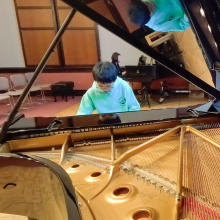The New York Times
Music Review: Persona, an Opera Based on the Ingmar Bergman Film
By ANTHONY TOMMASINI
October 26, 2015
It’s understandable why many composers have turned to great films as subjects for operas. A film provides a ready-made narrative structure and, often, a score that suggests how music could be integrated. Still, a film as powerful as Ingmar Bergman’s “Persona,” released in 1967, might seem an intimidating source for a contemporary opera. What can music add?
The American composer Keeril Makan, far from being intimidated, was clearly inspired to take it on, judging from the effectiveness of his “Persona,” a chamber opera with a libretto by the director Jay Scheib, closely adapted from Bergman’s screenplay. The opera had its premiere on Friday — a two-night run — at National Sawdust, the multipurpose performance space in the Williamsburg section of Brooklyn that opened recently. This is the first commissioned collaboration between National Sawdust and Beth Morrison Projects, a promising inaugural effort that showed the potential of this intimate space for operatic works.
Bergman’s film is the story (followed closely in the opera) of a well-known actress, Elisabet Vogler, who is being treated in a hospital for a mysterious condition. Seemingly traumatized, Elisabet has barely moved and not spoken a word for three months. The doctor in charge asks a young nurse, Alma, to care for Elisabet. Alma asks to be excused, explaining that she lacks the mental strength to cope with Elisabet, who seems healthy enough yet remains silent. “She is too strong,” Alma says, perceptively.
The doctor offers her own weekend home on the seacoast to Alma and Elisabet as a place to stay while, hopefully, Elisabet recuperates. As days go by, Alma talks incessantly and openly about herself, confessing a sexual ménage. The needy nurse and the observant, silent actress develop a curious intimacy.
In the movie we sometimes glimpse a film crew hovering over Alma and Elisabet. That framing device is a central component of the opera as conceived for the intimate National Sawdust space, set up to accommodate 125 people. Long-armed cameras constantly followed the two central characters, showing them in live close-up videos on four screens.
Music comes first in any opera, and Mr. Makan’s 85-minute score, roughly as long as the film, compellingly drives the drama in “Persona.” Mr. Makan sets the text with striking sensitivity to when a moment demands conversational naturalness or supple lyricism. On the surface, the instrumental writing, scored for eight players (members of the Either/Or Ensemble), might seem like a backdrop, shifting from stretches of steady, pulsing chords to atmospheric sounds to squirrely riffs. But Mr. Makan’s acute ear for harmony and eerie textures draw you in continually.
The mezzo-soprano Amanda Crider made a winsome, vulnerable and, when the story turns dark, wildly volatile Alma, who for long stretches carries the entire opera, since Elisabet does not speak. Ms. Crider sang with deep expressivity and impressive stamina. The actress Lacey Dorn was a haunting Elisabet. Beneath her outward fragility and physical tenderness toward Alma, you sensed a disturbed yet strong-willed woman. Is the silent Elisabet an actress performing her greatest role? That’s one possible explanation.
Eve Gigliotti as the doctor and Joshua Jeremiah in a number of roles (Alma’s fiancé, Elisabet’s seemingly blind husband who briefly visits) were excellent. Evan Ziporyn conducted, alert throughout to the pungent details and rhythmic flow of the score.





